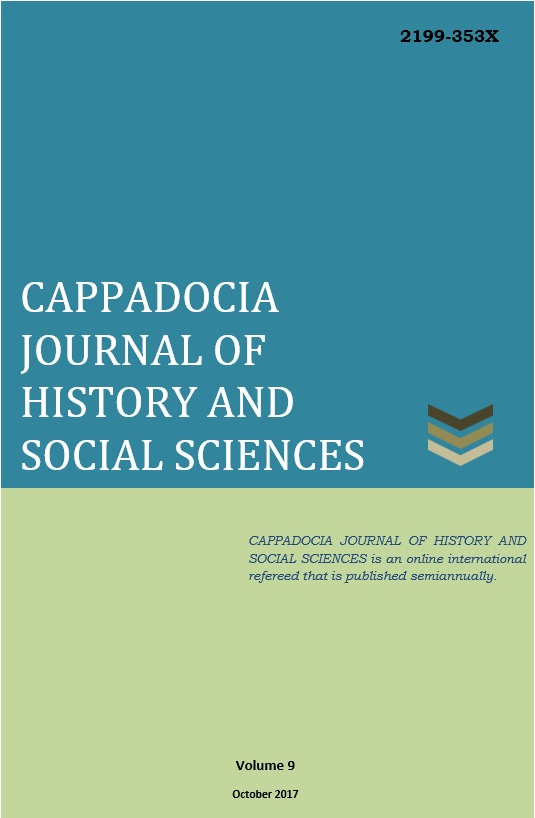Author :
Abstract
Memlûk Devleti’nin merkeziyetçi bir yönetim anlayışını geliştirdiği kabul edilmektedir. Ancak bu merkeziyetçi yönetim tezi, çeşitli yönlerden değerlendirilmemiş ve açıklanmamıştır. Bu makale, belirlenen başlıklar üzerinde Memlûklerin merkezileşme eğilimlerine dikkat çekmeyi amaçlamaktadır. Bu bağlamda veraset sistemi, memlûk kurumu, Moğol tesiri ve dönemin şartları, Kahire Abbasi Halifeliğinin Memlûk Devleti’ndeki durumu ve sosyo-ekonomik yansımaları gibi konular üzerine odaklanılacaktır. Her başlıkta konuya dair ulaşılan sonuçlar, yorumlar ve yaklaşımlar değerlendirilecektir.
Keywords
Abstract
It is accepted that Mamluk state advanced on a centralist administration approach. However, the centralist administration thesis has not been appraised and explained from various perspectives. This article aims at explaining Mamluks’ centralization tendency on selected topics. In this context such subjects as succession system, mamluk institution, Mongol influence and conditions of era, Cairo Abbasid Caliphate’s situation in the Mamluk state and socio-economic reflections will be focused. In each topic the reached results, comments and approachs relating to the subject will be evaluated.
Keywords
- - AMITAI-PREISS, Reuven, “Dealing with Reality: Early Mamluk Military Policy and the Allocation of Resources”, In Stefan Leder, ed. Crossroads between Latin Europe and the Near East: Frankish Presence in the Eastern Mediterranean (12th to 14th Centuries). Würzburg: Erlon Verlag, 2011, pp. 127-144.
- - AMITAI-PREISS, Reuven, “The Remaking of the Military Elite of Mamluk Egypt by Al-Nasir Muhammad b. Qalawun” Studia Islamica, No. 72 (1990), pp. 145-163.
- - AMITAI-PREISS, Reuven, “Mamluks of Mongol Origin and Their Role in Early Mamluk Political Life”, Mamluk Studies Review, Vol. 12, 2008, pp.119-137.
- - AMITAI-PREISS, Reuven, “Diplomacy and the Slave Trade in the Eastern Mediterranean: A Re-examination of the Mamluk-Byzantine-Genoese Triangle in the Late Thirteenth Century In Light of the Existing Early Correspondence”, Oriente Moderno, LXXXVIII, 2008, pp. 349-368.
- - AMITAI-PREISS, Reuven, “An Exchange of Letters in Arabic between Abaya Ilkhan and Sultan Baybars (A. H. 667/A. D. 1268-69)”, Central Asiatic Journal 38/1 (1994), pp. 11-33.
- - AYALON, David, “Mamluk”, The Encyclopaedia of Islam, Vol. VI, 1991, pp. 314-
- - AYALON, David, “The System of Payment in Mamluk Military Society”, Journal of the Economic and Social History of the Orient, Vol. 1, (1957), pp. 37-65.
- - AYALON, David, “The Great Yasa of Chingiz Khan: A Reexamination” Studia Islamica, 36 (1972), pp. 113-158.
- - AYALON, David, “Studies on the Transfer of The ‘Abbasid Caliphate from Bagdad to Cairo”, Arabica, T. 7, Fasc. 1 (Jan., 1960), pp. 41-59.
- - AYALON, David Neustadt, “The Plague and its Effects upon the Mamluk Army”, The Journal of the Royal Asiatic Society of Great Britain and Ireland, No. 1 (1946), pp. 67
- - AYALON, David, “Memluk Devletinde Kölelik Sistemi”, çev. Samira Kortantamer, Tarih İncelemeleri Dergisi IV (1989), s. 211-247.
- - BROADBRIDGE, Anne, “Mamluk Legitimacy and the Mongols: The Reigns of Baybars and Qalawun”, Mamluk Studies Review, Vol. 5, 2001, pp. 91-118.
- - CLIFFORD, Winslow William, State Formation and the Structure of Politics in Mamluk Syro-Egypt, 648-741 A.H./1250-1340 C.E., University of Chicago, 1995.
- - HOLT, P. M., “Mamluk-Frankish Diplomatic Relations in the Reign of Qalawun (678- 89/1279-90)”, The Journal of the Royal Asiatic Society of Great Britain and Ireland, No. 2 (1989), pp. 278-289.
- - HUMPREYS, R. Stephen, “Ayyubids, Mamluks, and the Latin East in the Thirteenth Century”, Mamluk Studies Review, Vol. 2, 1998, pp.1-17.
- - HUMPREYS, R. Stephen, “The Politics of the Mamluk Sultanate: A Review Essay”, Mamluk Studies Review, Vol. 9, 2005, pp.221-231.
- - HUMPREYS, R. Stephen, “The Emergence of the Mamluk Army”, Studia Islamica, No. 46 (1977), pp. 147-182.
- - İBN İYAS, Muhammed bin Ahmed, Bedai’z-Zuhur fi-Vekai’d-Duhur, Kahire 1960.
- - KIZILTOPRAK, Süleyman, “Memluk Sistemi”, Türkler, c. 5, Ankara 2002, s. 320-
- - KOPRAMAN, Kazım Yaşar, “Mısır Memlukleri (1250-1517)”, Türkler, c. 5, Ankara 2002, s. 99-126.
- - KORTANTAMER, Samira, “Memluklarda Devlet Yönetimi ve Bürokrasi”, Tarih İncelemeleri Dergisi II (1984), s. 27-45.
- - LAPIDUS, Ira M., “Mamluk Patronage and the Arts in Egypt: Concluding Remarks” Muqarnas, Vol. 2, The Art of the Mamluks (1984), pp. 173-181.
- - LAPIDUS, Ira M., “The Grain Economy of Mamluk Egypt”, Journal of the Economic and Social History of the Orient, Vol. 12, No. 1 (Jan., 1969), pp. 1-15.
- - LEVANONI, Amalia, “The Mamlûk in Egypt and Syria: the Turkish Mamlûk sultanate (648-784/1250-1382) and the Circassian Mamlûk sultanate”, in Maribel Fierro (ed.), The New Cambridge History of Islam, II (Cambridge, 2010), pp. 237-284.
- - LEVANONI, Amalia, ”The Mamluk Conception of the Sultanate”, International Journal of Middle East Studies, 26 (1994), 373-392.
- - el-MAKRİZİ, Takıyüddin Ahmed bin Ali, Kitab es-Süluk li-Marifet Düvel el-Müluk, (thk. Muhammed Abdülkadir ‘Ata), [el-Mektebetü’ş-Şamile], Darü’l- Kütübi’lİlmiyye, Beyrut 1997.
- - STEWART, Angus, “Between Baybars and Qalawun: Under-age Rulers and Succession in the Early Mamluk Sultanate”, Al-Masaq, Vol. 19, No. 1, 2007, pp. 47
- - TSUGITAKA, Sato, “The Proposers and Supervisors of al-Rawk al-Nasiri in Mamluk Egypt”, Mamluk Studies Review, Vol. 2, 1998, pp.73-92.
